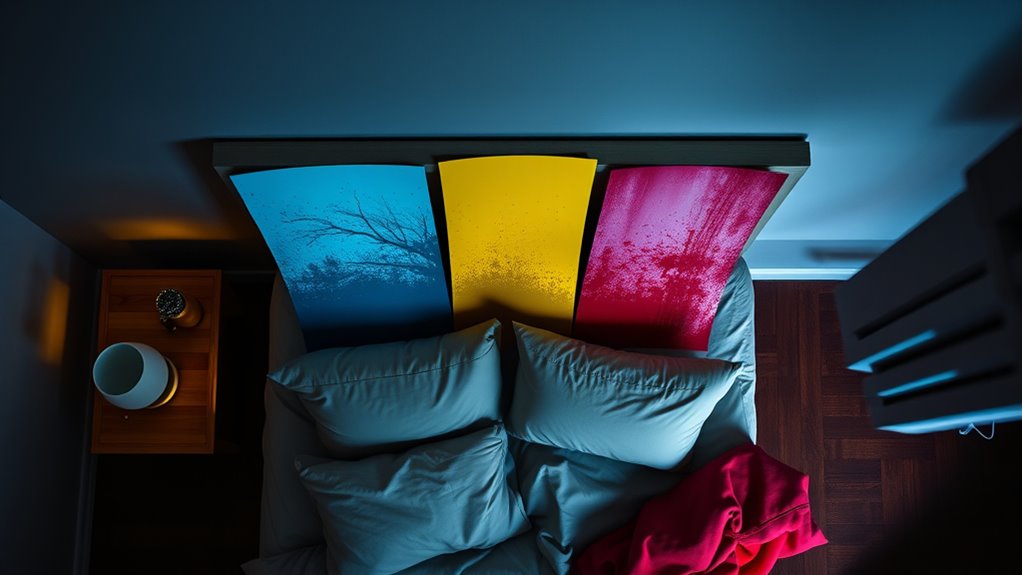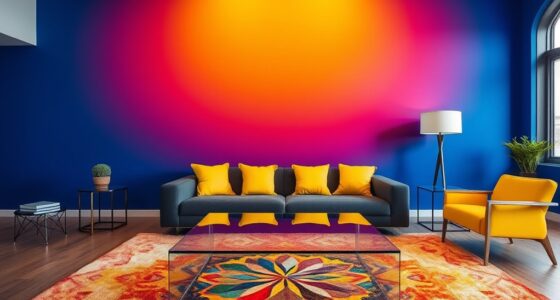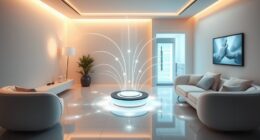Psychologists advise avoiding bright red, intense yellow, sharp lime green, dark gray, and neon pink in your bedroom because these colors can overstimulate your mind and disrupt relaxation. Bright red and neon pink may cause restlessness, while bold yellow and lime green can heighten anxiety or energy levels. Dark gray often feels heavy or oppressive, making it harder to unwind. To create a calming space, stick to softer, muted tones—continue to explore how color choices influence your sleep and mood.
Key Takeaways
- Bright red can increase passion but may cause restlessness, making it unsuitable for promoting relaxation in bedrooms.
- Intense yellow might boost mood temporarily but can also induce anxiety, disrupting sleep and calmness.
- Sharp lime green creates visual stimulation that hinders relaxation and keeps the mind overly alert.
- Overusing dark gray can make a bedroom feel oppressive and dampen mood, reducing tranquility.
- Neon pink stimulates high energy levels and excitement, which can interfere with restful sleep and peaceful ambiance.
Bright Red
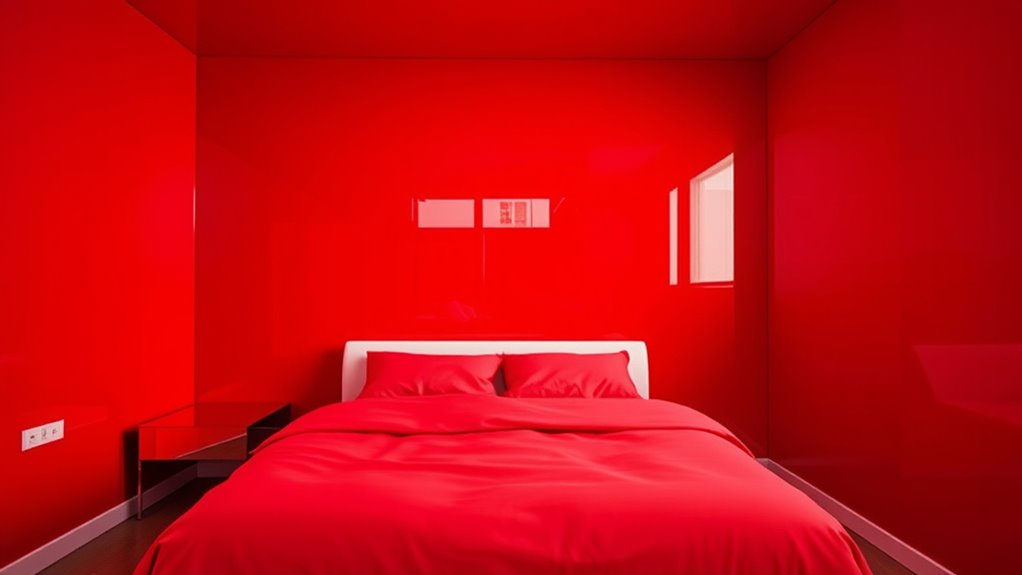
Although bright red may seem like an energizing choice, it’s generally not ideal for bedroom walls. Color psychology shows that red can evoke strong emotional impacts, often increasing feelings of passion or excitement. However, in a bedroom, this intensity can be overwhelming and hinder relaxation. The emotional impact of bright red might make it harder to unwind after a long day, potentially causing restlessness or agitation. While red is associated with warmth and love, its stimulating nature can interfere with sleep and calmness. If you want a cozy, restful environment, bright red isn’t the best option. Instead, opt for softer, more muted tones that promote tranquility and comfort, supporting a peaceful atmosphere for rest and rejuvenation. Additionally, understanding Color psychology can help you choose shades that foster relaxation rather than stimulation.
Intense Yellow
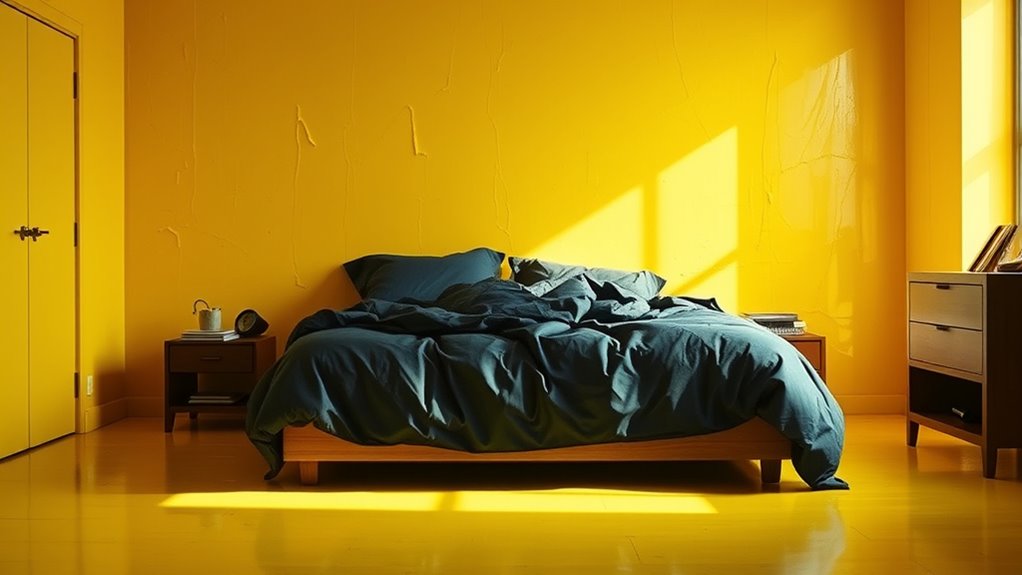
Intense yellow can make a room feel lively and energetic, but it’s often too stimulating for a bedroom. The psychological effects of color show that bright yellow can boost mood temporarily, yet it may also cause feelings of agitation or anxiety over time. Cultural associations with yellow vary; in some cultures, yellow symbolizes happiness and optimism, but in others, it can represent caution or even cowardice. When used excessively, intense yellow can overwhelm your senses, making it difficult to relax or unwind. If you want a calming space, this shade might backfire, leading to restlessness instead of comfort. For a bedroom designed to promote rest, softer or more muted tones are usually better choices. Intense yellow’s energy is better suited for lively spaces, not your sanctuary. Additionally, automation technologies in industries like education and logistics demonstrate how energy-efficient design choices can influence mood and productivity.
Sharp Lime Green
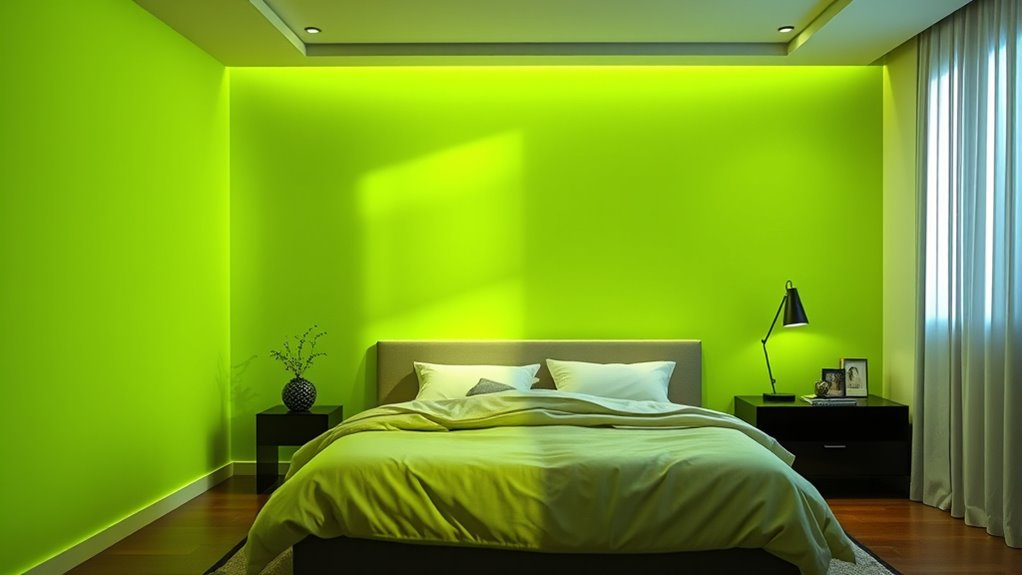
Sharp Lime Green may seem lively and fresh, but it can be too jarring for a bedroom. Its intense hue creates strong visual stimulation, which can hinder relaxation and restful sleep. Psychologically, this color can evoke feelings of energy and agitation rather than calm. The heightened psychological effects of lime green may make it difficult to unwind after a long day. Instead of promoting tranquility, it can keep your mind alert and prevent you from settling into a peaceful state. If you’re looking for a bedroom color that encourages rest and serenity, sharp lime green is best avoided. Its vibrant nature may energize your space temporarily, but it ultimately disrupts the calming environment essential for quality sleep.
Dark Gray

Dark gray can make your bedroom feel somber and oppressive if not used carefully. Its psychological effects often include feelings of gloom or heaviness, which may hinder relaxation and restful sleep. Aesthetic considerations are vital; while gray can evoke sophistication, too much can dampen your mood. To avoid an unsettling atmosphere, consider balancing dark gray with lighter accents or natural elements. Keep in mind that this color might not promote the calming environment you want. If you’re aiming for tranquility, dark gray could unintentionally create a sense of confinement. Additionally, market growth in AI tech suggests that incorporating calming colors like blues or greens may positively influence mood and mental health in your space.
Neon Pink
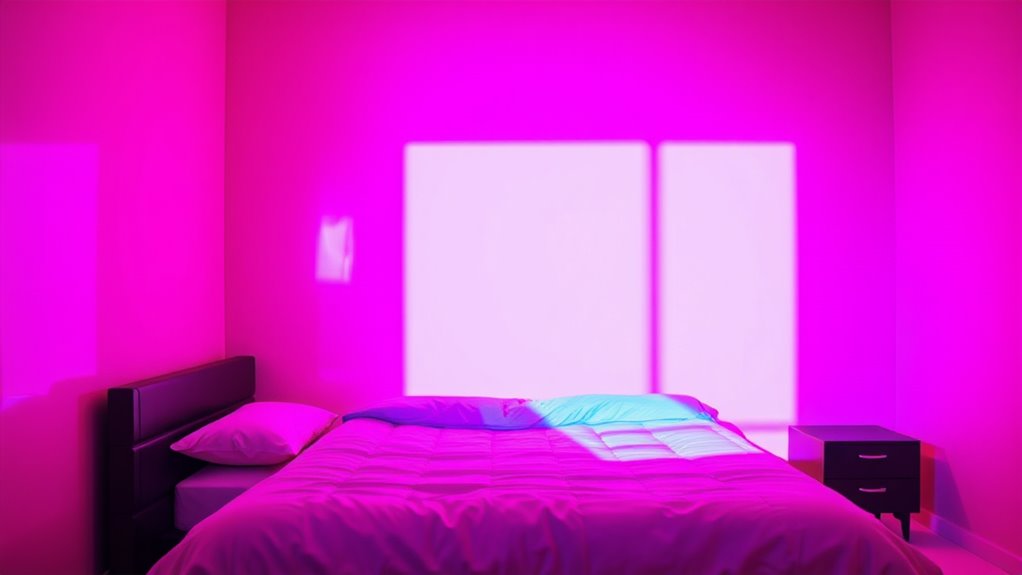
Have you ever considered how neon pink can drastically alter the mood of your bedroom? Its bold, vibrant hue offers a striking aesthetic appeal, but the psychological effects might not be what you expect. Neon pink can stimulate high energy levels, making it difficult to relax or unwind at the end of the day. This intense color often leads to feelings of excitement or agitation, rather than calm and tranquility, which are essential for a restful sleep environment. While it may seem fun and lively, neon pink’s overwhelming brightness can cause sensory overload, disrupting your mood and sleep quality. If you want a peaceful space, this color is best avoided, despite its eye-catching aesthetic appeal. Additionally, protective styling benefits of certain colors can influence how calming or stimulating a room’s atmosphere feels, so choosing shades carefully is important for creating a restful environment.
Frequently Asked Questions
Can These Colors Affect My Sleep Quality?
The colors in your bedroom can definitely affect your sleep quality. Cooler color temperatures, like soft blues and greens, promote relaxation, while warmer tones might energize you. High color saturation can be stimulating, making it harder to wind down. To improve sleep, choose low saturation, calming colors with a cooler temperature. Your choice of color impacts your mood and sleep, so pick hues that foster tranquility.
Are There Any Colors That Promote Relaxation?
Imagine your bedroom as a sanctuary, where color therapy transforms it into a peaceful retreat. Soft, muted hues like gentle blues, calming greens, and warm neutrals promote relaxation and serve as sleep-inducing hues. These colors symbolize tranquility and balance, helping you unwind after a busy day. Incorporating sleep-inducing hues creates a soothing atmosphere, making it easier to drift off and enjoy restful, restorative sleep every night.
How Do Colors Influence Bedroom Mood and Ambiance?
Colors influence your bedroom mood and ambiance through color therapy and symbolism. Bright, calming hues like blue and green promote relaxation, reducing stress. Warm colors like red and yellow can energize or create a lively atmosphere, while neutral tones foster serenity. Understanding color symbolism helps you choose shades that reflect your desired mood. You shape your space’s vibe by selecting colors that evoke the emotions you want to experience daily.
Do Personal Preferences Override Psychological Effects of Colors?
Personal preferences and cultural influences play a significant role in how you respond to color choices. While psychological effects suggest certain colors can boost mood or relaxation, your personal taste might lead you to select hues that feel more authentic or comforting, even if they don’t align with psychological recommendations. Ultimately, trusting your instincts and cultural context guarantees your space reflects your personality and promotes genuine comfort.
Can Wall Paint Colors Impact Mental Health Long-Term?
Studies show that color psychology can influence your mood long-term, with color therapy often used to promote well-being. Your wall paint colors may impact mental health over time if they evoke positive or negative feelings. For example, calming blues can reduce stress, while overly stimulating reds might increase anxiety. So, choose colors wisely, understanding how color therapy works to support your mental health in the long run.
Conclusion
Steering clear of these colors is like avoiding storm clouds on a clear day—you keep your peace intact. Bright red, intense yellow, sharp lime green, dark gray, and neon pink can turn your sanctuary into a battlefield of emotions. Instead, choose calming shades that nurture your mind and body. Remember, your bedroom should be your refuge, not a battleground. Keep the colors gentle, and let tranquility be your guiding hue.
